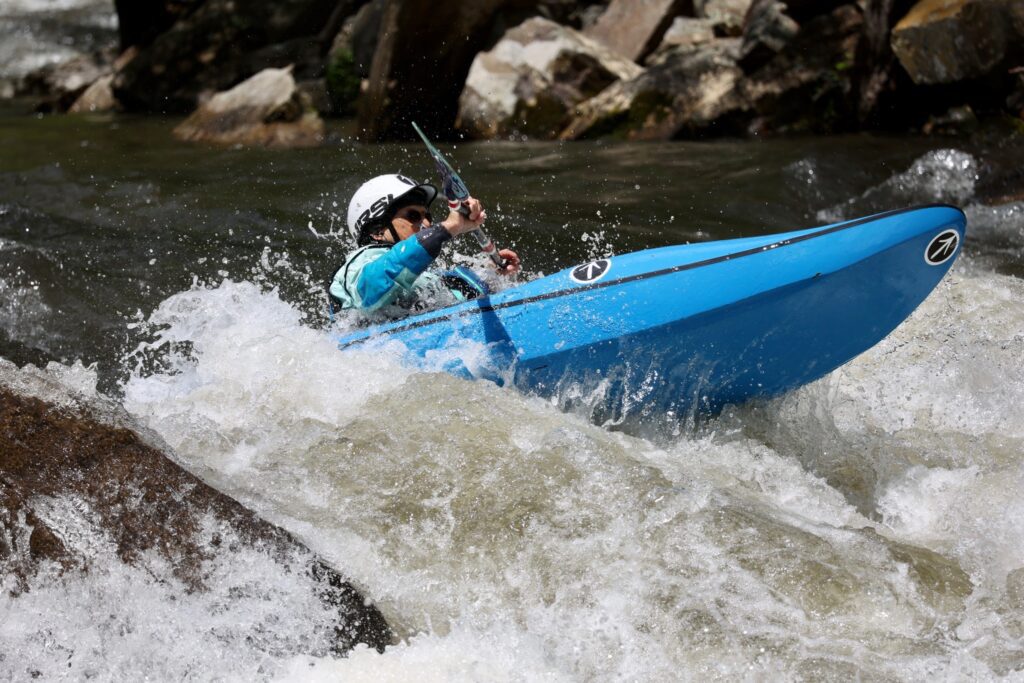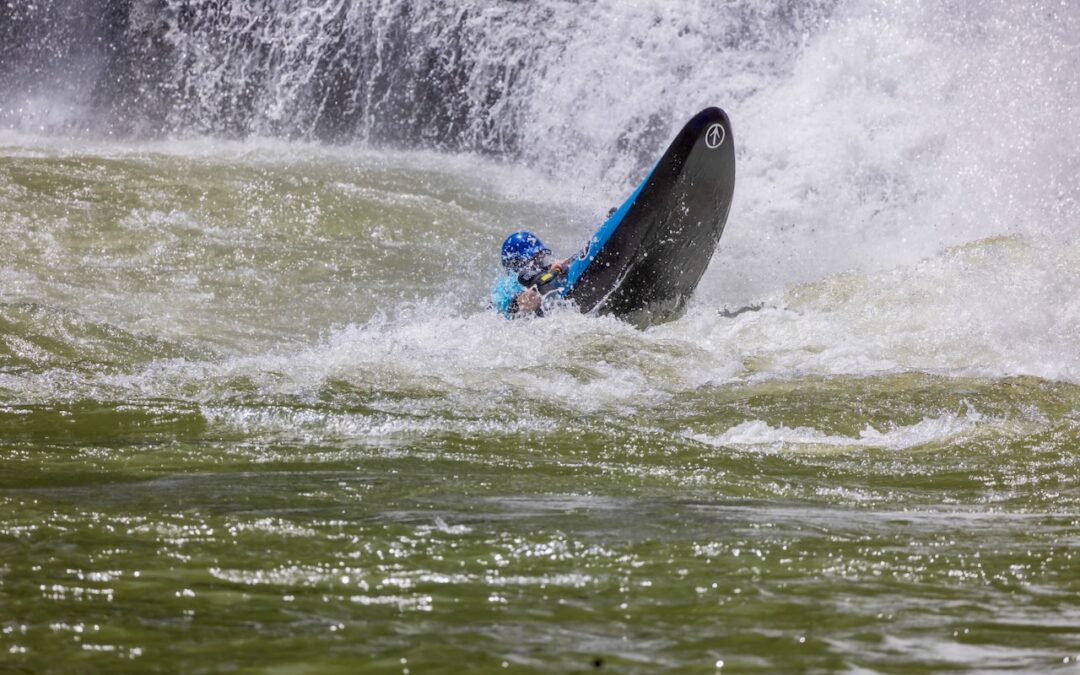
Rolling or Bracing? Brace! but if it fails, don’t stress, roll right up!
If you know me, you know how important I believe having a bombproof roll and brace is to truly enjoying paddling in a much more stress free way. Certainly there are other factors in your paddling, but lack of confidence in your roll or brace makes it tougher to look at rapids with the same confidence you would if you know that you likely won’t flip over (good brace), but if you do, you’ll roll right up on your first try, quickly (good roll).
I am writing this blog 2 days before 2025, on December 30th, 2024. If you are like me, you are looking at the new year, making some plans, getting excited for things you will do that are fun, good for you, and memorable. I challenge you to get your roll up to snuff. Swimming Pools, go south to warmer waters, or get a dry suit, and scull cap and brave the cold water for practice. Any or all of those ways to practice in the winter are good to go.
I highly recommend, like any journey, to start at the beginning, and get the basics down. Below are some videos that will give you each step of the way. If you are an instructor, responsible for others getting their roll and brace down, and you want to be someone who does a good job for them, and not add to their stress, please review my “Teaching the Roll Video” at the end.
A word of caution, and a heads up that “EJ’s Rolling and Bracing” is a program that gets only 2 kinds of reviews from my peers. “Best system ever” or “Dangerous and should be removed from the internet”. I am quite comfortable in my knowledge that out of what is available, it is the most effective way to teach rolling that exists, and that those who think it is just plain “bad, and in some cases Irresponsible” are simply ignorant instructors, who would rather regurgitate the bad information that they learned from their instructor, versus spend even a little bit of time analyzing what I am teaching, and they would quickly realize that the things they are saying about it are simply 180 degrees backwards. 100% of the criticism that people have for my program are related to things that with just a tad bit of thought, they would realize that they have been given bad information. I am only telling you this stuff because you WILL run into at least one person, who if you say, “I am going to follow EJ’s Rolling and Bracing program to get better, will tell you that you should not do that. “Just learn the C to C roll.” Or some other roll with a name attached to it. Here is where the kayak career ruining old wives tale/tales came from.
Back in the early 90’s 2nd and 3rd tiers slalom racers who taught paddling (the best ones were not instructing, they were racing in 99% of the situations) and instructors mimicking them, started telling students that they way people were rolling was bad and everyone needed to start rolling up leaning forwards. The concept caught on and still exists today, like a bad joke that people believed in and made it into the instructor manual. Bummer. Further, it has been said that the way I teach rolling puts your shoulders at risk, again, that is 180 degress backwards. It protects them as well as you can and do the roll. OK, you will either use this system, which has about 10 times as many kayakers out there using it as any other, or not. If you do and practice, you’ll find rolling so much easier and more fun. “Tipping over in a rapid can be part of the fun of kayaking, if you know you’ll roll up quickly, everytime.”
Let’s get started: “Phase 1”. Here you’ll learn the most important part of the roll, the hip snap. FYI- if you can’t do a 1 handed hand roll, you do not have a good hip snap!! Period.
Phase 2: Learning what it feels like to pull down on your paddle blade to engage your hip snap is important and it is your first roll where it is just you and the water.
Phase 3: being able to get your paddle in a position that you can roll at with nobody helping, is a real thing. You are almost there.
Phase 4: OK, so getting your paddle into position to roll while underwater, from the “home base” to “roll position”. This is the hardest things for most people to accomplish in the beginning.
Phase 5: Here we learn how to get to home base while underwater, and hit the roll from there. This is the phase that 90+% of paddlers never practice and the single biggest reason why most paddlers struggle with their roll.
Phase 6: The intuitive roll- Remember that a “good roll is first time everytime” and a great roll is “First time everytime, really fast”. We teach you how to roll without setting up.
Anyone who says you need to do “this technique or that technique” isn’t focused on what makes for a good roll. If you get enough purchase on your paddle for a good hip snap, you will roll right up.
OK Bombproofing your Roll- this is a mental exercise, as well as simply practicing phase 5 and 6 in flatwater, and then putting yourself in a place where you will accidently tip over and have to practice in whitewater. The best place to do that is playboating, of course. Surfing holes and waves where you’ll find yourself tipping over and over again, is where you get comfortable with the roll. If you never get a chance to see what it feels like in whitewater, you’ll build up your fear of actually having to perform and it will get in the way of success. If you find a hole you can surf that you tip over 20 times in one day, you’ll lose almost all fear of flipping. You have to continue to desensitize yourself every year, every month perhaps, if you want to be 100% comfortable. If you haven’t already noticed, the best creekboaters in the world are all freestyle kayakers. This is for three reasons, 1. they learn a very fast, confident roll, and 2. they learn how to deal with holes, and 3. they learn an awesome brace. Kayakers that don’t ever play, are almost never verticle in their boats, unless they are out of control, they flip so rarely that they stress about flipping, and when they see a big hole it scares the crap out of them, while a freestyle boater KNOWS if they can get out or not, because they surf holes all of the time.
Safety- two main things that determine how “safe” your roll is.
- How quickly you roll up. If you spend an average of 5 seconds underwater every time you flip over and I spend 1 second under water, you are 5 times more likely to hit something underwater, you will get disoriented much easier, and you will travel likely 5 times further underwater and are way more likely to end up in a bad position.
- Your percentage of hitting your first roll. If you hit 100% of your first attempts, you are way safer than someone who averages 2 attempts per successful roll. FYI- most people who get hurt from hitting rocks when they flip over, hit them by “falling onto them” when tipping over or missing a roll. The impact is way greater than when already upside down. Missing rolls is 2 times more likely if you roll up in a forward position. AND your body goes deeper in the water when you tip over sitting up or forward than it does if you are on the back deck.
Teaching the roll:
Instructors like to talk a lot to students who are learning to roll. This is not only a waste of time, but it cuts the chances of success down a lot, slows the process, and frustrates the paddler. Yes, some paddlers are very detail oriented and want to ask questions and hear your responses, but they don’t know what is good for them for this reason- we all have limited Random Access Memory. When we are underwater our brain is like a computer with every program running at the same time and our computer crashes. Few paddlers learning to roll can do math problems underwater that they can do easily right side up. Eliminating the “noise” the extra information, and controlling the thought process of the student is the #1 strategy of the teacher. Walking the student through the phases with minimal coaching and a singular focus assures that you don’t run out of RAM as easily, and forcing the student to “Stop talking”, “stop thinking”, “look at me, just do this motion, OK, do that motion again…”. “Now, don’t think, just tip over and copy that motion and then hip snap” for example are words that you might hear if I am teaching the roll to somebody.
In any endeavor successful people have an overarching strategy that they are using for success and then they create tactics to carry out the steps needed for success in navigating the strategy. “The difference between the professional and amateur, is that the professional focuses on strategy while the amateur focuses on tactics.” Churchill.
You will never hear me say I am teaching a sweep roll, a C to C roll, nor do I have a specific paddle motion that I say you should use when rolling. Those are tactics and of course you can use any of them successfully. It is the strategy of being able to get set up with your paddle somewhere in the range of where if you do a good hip snap, you will roll up. You will never see me set up to “home base” before I roll because it is a waste of time and not as safe (takes 3 seconds versus 1). People say, are you doing a back deck roll? “No, I am just hip snapping up with my paddle in whatever position I find it in, more or less, when I flip over”. Of course that takes practice, and setting up before you tip over 1 million times won’t teach that skill.
Your job is to watch the videos, get to the water with a friend or two, practice from the very beginning, get your friends to video you. When you can do a 1 handed hand roll, you have a good hip snap and you are likely to be rocking every roll you do with a paddle!
Here is when I taught KC to roll:
If you are teaching kids, here is what my kids had to say back in 2003:
Bracing- get on that program ASAP- it teaches paddle dexterity and more. Having a good brace, and having it top of mind eliminates most of your flips. Now we are talking!
See you on the river! FYI- I do clinics at Rock Island and they are heavy on rolling and bracing, as well as strokes and concepts (Most people never learn some absolutely critical skills for being effective, efficient, fast, and confident on the water related to strokes and concepts)- the people I coach (my kids, team, etc.) learned them and that foundation is what allows them to go the the levels they have gone to.
Here are the first 4 phases explained back in 2003 when Dane was 10 and Emily was 13:

